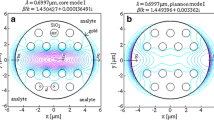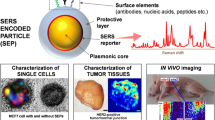Abstract
In the present study, an ultra-sensitive surface plasmon resonance biosensor is developed. The device is composed of a CaF2-prism, silver, silicon nitride, nickel, and black phosphorus have been deposited. The setup is grounded in the Kretschmann configuration and theoretically analyzed by means of transfer matrix method and Fresnel equations. For selective diagnosis of liver tissue and its mutation in terms of variation in RI, the biosensor provides an ultrahigh angular sensitivity of 383.62°/RIU for MET tissue and 403.92°/RIU for HCC tissue. The optimization of angular sensitivity and other sensor parameters in terms of thickness and number of layers has also been utilized. To validate the reflectance curve, electric field intensity enhancement factor and phase interrogation have also been conducted. The acquired results state that the proposed biosensor yields an enhanced sensitivity when compared to other reported results. Due to its advantage of fast, accurate and early-stage detection of liver mutations with a very small number of samples, this report may expedite a sensing device for commercial applications.











Similar content being viewed by others
Data Availability
Data will be made available on request.
References
Bray F, Ferlay J, Soerjomataram I, Siegel R L, Torre LA, Jemal A (2018) Global cancer statistics 2018: GLOBOCAN estimates of incidence and mortality worldwide for 36 cancers in 185 countries. CA Cancer J Clin 68:394–424
Fong Y, Fortner J, Sun R L, Murray †, Brennan F, Blumgart L H Clinical score for predicting recurrence after hepatic resection for metastatic colorectal cancer analysis of 1001 consecutive cases. 230
El-Serag HB, Rudolph KL (2007) Hepatocellular carcinoma: epidemiology and molecular carcinogenesis. Gastroenterology 132:2557–2576
Mishra AC, Dandapat K, Tripathi S M, Lohia P, Dwivedi DK (2020) Modelling and analysis of chirped long-period grating inscribed in a planer optical waveguide structure for sensing applications. J Opt Commun
Yadav A, Kumar A, Sharan P, Mishra M (2023) Highly sensitive bimetallic-metal nitride SPR biosensor for urine glucose detection. IEEE Trans Nanobioscience
Yadav A, Kumar S, Kumar A, Sharan P (2023) Effect of 2-D nanomaterials on sensitivity of plasmonic biosensor for efficient urine glucose detection. Front Mater 9
Yadav A, Kumar A, Sharan P (2022) Sensitivity enhancement of a plasmonic biosensor for urine glucose detection by employing black phosphorous Journal of the Optical Society of America B 39:200
Srivastava S, Singh S, Mishra AC, Lohia P, Dwivedi DK (2023) Numerical study of titanium dioxide and MXene nanomaterial-based surface plasmon resonance biosensor for virus SARS-CoV-2 detection. Plasmonics
Yoo H, Shin J, Sim J, Cho H, Hong S (2020) Reusable surface plasmon resonance biosensor chip for the detection of H1N1 influenza virus. Biosens Bioelectron 168
Jabin MA, Ahmed K, Rana MJ, Paul BK, Islam M, Vigneswaran D, Uddin MS (2019) Surface plasmon resonance based titanium coated biosensor for cancer cell detection. IEEE Photonics J 11
Sahoo PR, Swain P, Nayak SM, Bag S, Mishra SR (2016) Surface plasmon resonance based biosensor: a new platform for rapid diagnosis of livestock diseases Vet. World 9:1338–1342
Popescu VA, Sharma AK (2019) Simulation and analysis of different approaches towards fiber optic plasmonic sensing for detection of human-liver tissues. Opt Quantum Electron 51
Yu H, Han R, Su J, Chen H, Li D (2020) Multi-marker diagnosis method for early hepatocellular carcinoma based on surface plasmon resonance. Clin Chim Acta 502:9–14
Hasib MHH, Nur JN, Rizal C, Shushama KN (2019) Improved transition metal dichalcogenides-based surface plasmon resonance biosensors Condens Matter 4:1–11
Blázquez O, López-Vidrier J, Hernández S, Montserrat J, Garrido B (2014) Electro-optical properties of non-stoichiometric silicon nitride films for photovoltaic applications. Energy Procedia 44:145–150
Chevalier J, Gremillard L, Virkar AV, Clarke DR (2009) The tetragonal-monoclinic transformation in zirconia: lessons learned and future trends. J Am Ceram Soc 92:1901–1920
Dergez D, Schneider M, Bittner A, Schmid U (2015) Mechanical and electrical properties of DC magnetron sputter deposited amorphous silicon nitride thin films. Thin Solid Films 589:227–232
Kumar A, Kumar A, Srivastava SK (2022) Silicon nitride-BP-based surface plasmon resonance highly sensitive biosensor for virus SARS-CoV-2 detection. Plasmonics 17 1065–77
Mudgal N, Saharia A, Choure KK, Agarwal A, Singh G (2020) Sensitivity enhancement with anti-reflection coating of silicon nitride (Si3N4) layer in silver-based surface plasmon resonance (SPR) sensor for sensing of DNA hybridization. Appl Phys A Mater Sci Process 126
Zhu C, Zeng Z, Li H, Li F, Fan C, Zhang H (2013) Single-layer MoS2-based nanoprobes for homogeneous detection of biomolecules. J Am Chem Soc 135 5998–6001
Cai S, Yang R (2020) Two-dimensional nanomaterials with enzyme-like properties for biomedical applications. Front Chem 8
Liu H, Neal AT, Zhu Z, Luo Z, Xu X, Tománek D, Ye PD (2014) Phosphorene: an unexplored 2D semiconductor with a high hole mobility. ACS Nano 8:4033–41
Xia F, Wang H, Jia Y (2014) Rediscovering black phosphorus as an anisotropic layered material for optoelectronics and electronics. Nat Commun 5
Singh S, Singh PK, Umar A, Lohia P, Albargi H, Castañeda L, Dwivedi DK (2020) 2D nanomaterial-based surface plasmon resonance sensors for biosensing applications Micromachines (Basel) 11
Buscema M, Groenendijk DJ, Blanter SI, Steele GA, Van Der Zant HSJ, Castellanos-Gomez A (2014) Fast and broadband photoresponse of few-layer black phosphorus field-effect transistors. Nano Lett 14:3347–3352
Karki B, Ramya KC, Sandhya Devi RS, Srivastava V, Pal A (2022) Titanium dioxide, black phosphorus and bimetallic layer-based surface plasmon biosensor for formalin detection: numerical analysis. Opt Quantum Electron 54
Singh Y, Raghuwanshi SK (2019) Sensitivity enhancement of the surface plasmon resonance gas sensor with black phosphorus. IEEE Sens Lett 3
Kaur B, Sharma AK (2018) Plasmonic biosensor in NIR with chalcogenide glass material: on the role of probe geometry, wavelength, and 2D material. Sens Imaging 19
Shalabney A, Abdulhalim I (2010) Electromagnetic fields distribution in multilayer thin film structures and the origin of sensitivity enhancement in surface plasmon resonance sensors Sens Actuators A Phys 159:24–32
Shivangani, Alotaibi MF, Al-Hadeethi Y, Lohia P, Singh S, Dwivedi D K, Umar A, Alzayed H M, Algadi H, Baskoutas S (2022) Numerical study to enhance the sensitivity of a surface plasmon resonance sensor with Bluep/WS2-covered Al2 O3-nickel nanofilms. Nanomaterials 12
Pandey AK, Sharma AK (2018) Simulation and analysis of plasmonic sensor in NIR with fluoride glass and graphene layer Photonics Nanostruct 28:94–99
Gan Z, Wang C, Chen Z (2018) Material structure and mechanical properties of silicon nitride and silicon oxynitride thin films deposited by plasma enhanced chemical vapor deposition Surfaces 1:59–72
Luke K, Okawachi Y, Lamont MRE, Gaeta AL, Lipson M (2015) Broadband mid-infrared frequency comb generation in a Si3N4 microresonator Conference on Lasers and Electro-Optics Europe-Technical Digest vol 2015-August (Institute of Electrical and Electronics Engineers Inc.)
Cho SY, Lee Y, Koh HJ, Jung H, Kim JS, Yoo HW, Kim J, Jung HT (2016) Superior chemical sensing performance of black phosphorus: comparison with MoS2and graphene. Adv Mater 28:7020–8
Giannios P, Toutouzas KG, Matiatou M, Stasinos K, Konstadoulakis MM, Zografos GC, Moutzouris K (2016) Visible to near-infrared refractive properties of freshly-excised human-liver tissues: marking hepatic malignancies. Sci Rep 6
Singh RK, Mishra AC, Lohia P, Dwivedi DK (2020) Simulation for enhancement in sensitivity of chalcogenide glasses-based fibre optic evanescent absorption sensor for malignant tissue detection Micro and Nanosystems 13:180–185
Mishra AC, Singh PK, Lohia P, Dwivedi DK (2019) Evanescent field absorption based fiber optic sensor using chalcogenide glasses for biological tissues detection Sens Lett 17:1–6
Wu L, Chu HS, Koh WS, Li EP, Koh S (2010) Highly sensitive graphene biosensors based on surface plasmon resonance
Ouyang Q, Zeng S, Jiang L, Qu J, Dinh XQ, Qian J, He S, Coquet P, Yong KT (2017) Two-dimensional transition metal dichalcogenide enhanced phase-sensitive plasmonic biosensors: theoretical insight. J Phys Chem C 121:6282–6289
Sharma AK, Kaur B (2018) Simulation and analysis of 2D material (MoS2/MoSe2) based plasmonic sensor for measurement of organic compounds in infrared. Optik (Stuttg) 157:161–9
Mishra AC, Sharma AK, Lohia P, Dwivedi DK (2023) Modelling and analysis of high-performing reconfigurable SPR refractive index sensor employing beryllium oxide, nickel, and Bluep/WS2 Nanomaterials Plasmonics
Singh S, Mishra AC, Singh S, Lohia P, Dwivedi DK, Yadav S (2023) Theoretical study of perovskite nano material based surface plasmon resonance biosensor for cancers cell detection. Optik (Stuttg) 289
Das N, Chatterjee S, Kumar S, Pradhan A, Panigrahi P, Vitkin IA, Ghosh N (2014) Tissue multifractality and Born approximation in analysis of light scattering: a novel approach for precancers detection. Sci Rep 4
Subramanian H, Pradhan P, Liu Y, Capoglu IR, Li X, Rogers J D, Heifetz A, Kunte D, Roy HK, Taflove A, Backman V, Chien S (2008) Optical methodology for detecting histologically unapparent nanoscale consequences of genetic alterations in biological cells
Wu L, Chu HS, Koh WS, Li EP (2010) Highly sensitive graphene biosensors based on surface plasmon resonance. Opt Express 18:14395
Nisha A, Maheswari P, Anbarasan PM, Rajesh KB, Jaroszewicz Z (2019) Sensitivity enhancement of surface plasmon resonance sensor with 2D material covered noble and magnetic material (Ni). Opt Quantum Electron 51
Pal S, Verma A, Saini JP, Prajapati YK (2019) Sensitivity enhancement using silicon black phosphorous–TMDC coated surface plasmon resonance biosensor IET. Optoelectronics 13:196–201
Uniyal A, Chauhan B, Pal A, Singh Y (2022) Surface plasmon biosensor based on Bi2Te3 antimonene heterostructure for the detection of cancer cells. Appl Opt 61 3711
Acknowledgements
One of the authors (Swati Srivastava) extends her heartfelt appreciation chiefly to the Physics and Material Science Department of Madan Mohan Malaviya University of Technology, Gorakhpur, for the invaluable opportunity and support provided throughout this research endeavor.
Funding
For this work, there was no financial support.
Author information
Authors and Affiliations
Contributions
Swati Srivastava: conceived the concept, developed the structure and methodology, collected, and investigated all the data and prepared the initial draft. Adarsh Chandra Mishra, Sapana Yadav & Sachin Singh: investigation and interpretation of data, reviewed the manuscript. Pooja Lohia & D. K. Dwivedi: Reviewed and edited the manuscript and provided guidance as mentors throughout the planning and execution of the research project. Rajesh Kumar Yadav & M. Khalid Hossain: Review and revise the manuscript.
Corresponding author
Ethics declarations
Ethical Compliance
All procedures performed in this work are theoretical and simulation based on the optical properties of biological samples. Thus, there is no need for any approval or ethical compliance.
Conflict of Interest
The author has not any conflict of interest.
Additional information
Publisher's Note
Springer Nature remains neutral with regard to jurisdictional claims in published maps and institutional affiliations.
Rights and permissions
Springer Nature or its licensor (e.g. a society or other partner) holds exclusive rights to this article under a publishing agreement with the author(s) or other rightsholder(s); author self-archiving of the accepted manuscript version of this article is solely governed by the terms of such publishing agreement and applicable law.
About this article
Cite this article
Srivastava, S., Yadav, S., Mishra, A.C. et al. Ultra-Sensitive Surface Plasmon Resonance Biosensor for Liver Metastases and Hepatocellular Carcinoma Detection Using Silicon Nitride and Black Phosphorus Nanomaterial. Plasmonics 19, 1031–1041 (2024). https://doi.org/10.1007/s11468-023-02059-6
Received:
Accepted:
Published:
Issue Date:
DOI: https://doi.org/10.1007/s11468-023-02059-6




